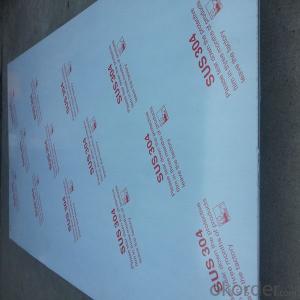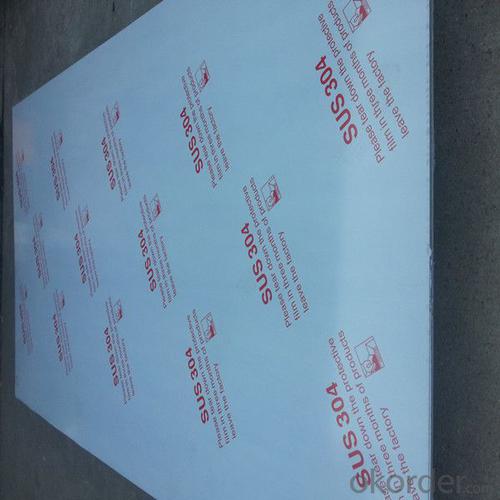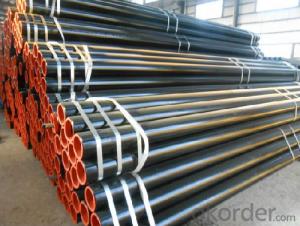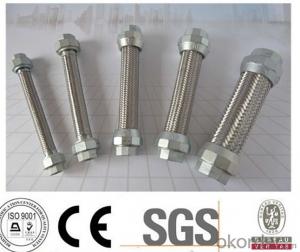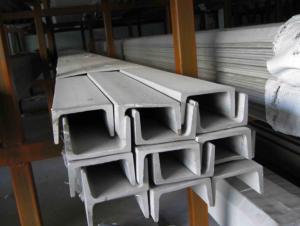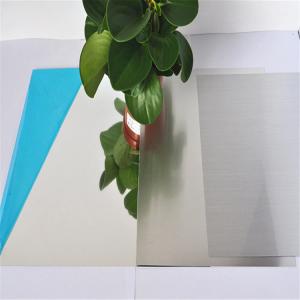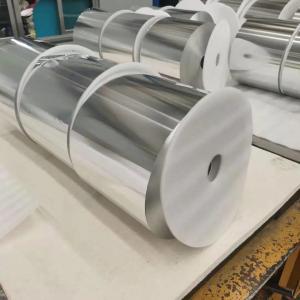RHS Stainless Steel Pipes - Factory Price 304L Stainless Steel Sheet
- Loading Port:
- Shanghai
- Payment Terms:
- TT OR LC
- Min Order Qty:
- 5 m.t.
- Supply Capability:
- 3000 m.t./month
OKorder Service Pledge
OKorder Financial Service
You Might Also Like
Specification
Factory price 304L stainless steel sheet !!!
1.hot rolled and cold rolled stainless steel sheet detailed information:
Type | 304L stainless steel sheet |
Thinckness | 0.3mm-60mm |
Widthness | 50mm~2000mm |
Length | 2000mm~8000mm or as request |
Brand name | TISCO |
Standard | JIS, AISI, ASTM, GB, DIN, EN |
Material | 304L,304,316,316L,309S,310S,321,317,301,904L,201,202,430,410,420, etc |
Surface | 2B,BA,HL,BK,NO.1,NO.4,etc |
Certificate | We accept the third inspections |
Application | Bridge, Shipbuilding,roofing,Car, etc |
Payment | T/T, 30% deposit, blance before loading, L/C |
Note | We can produce other standard as the customers’ require |
2. 304L stainless steel sheet Applications :
| Finish | Thickness | Characteristics | Applications |
| No. 1 | 3.0mm~50.0mm | Finished by hot-rolling, annealing and pickling, characterized by white pickled surface | Chemical industry equipment, Industrial tanks |
| No. 2B | 0.3mm~6.0mm | Finished by heat treatment, pickling after cold rolling, followed by skin pass line to be more brighter and smooth surface | General Application Medical Instruments,Tableware |
| No. BA (Bright Annealed) | 0.5mm~2.0mm | Bright heat treatment after cold rolling | Kitchen utensil, kitchen ware,architectural purpose |
| No. 4 | 0.4mm~3.0mm | Polishing with No. 150 to No.180 mesh abrasivesThe most popular finishes | Milk & Food processing acilities, Hospital Equipment, Bath-tub |
| HL(Hair Line) | 0.4mm~3.0mm | Finished by continuous linear polishing | Architectural purposes, escalators, kitchen ware vehicles |

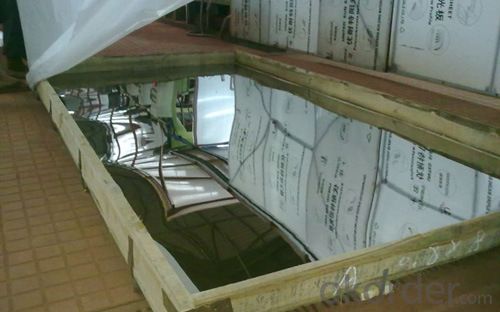
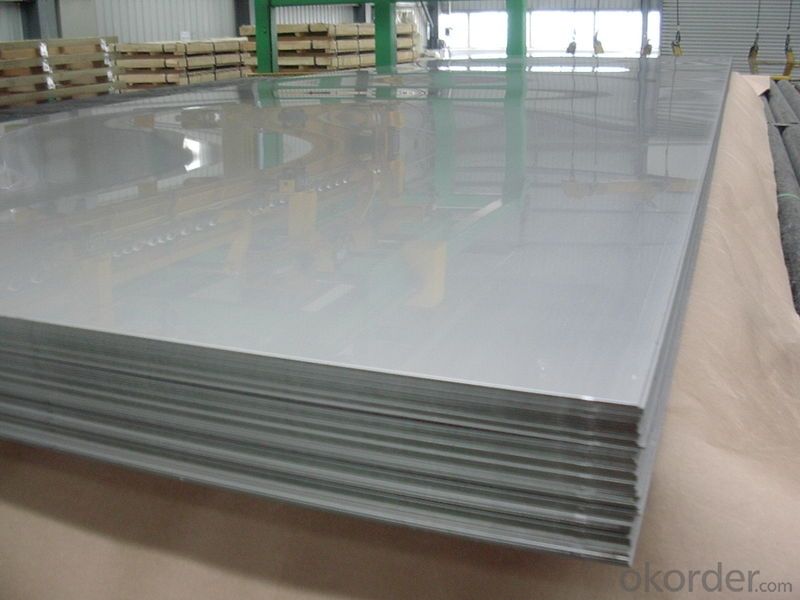
Why do you choose us?
1) Our products are high quality and best price.
2)We have experience in this line for many years.
3)We have professional team and the factory.
4)It's very important for a company to be honest in the process of trading and so do we.
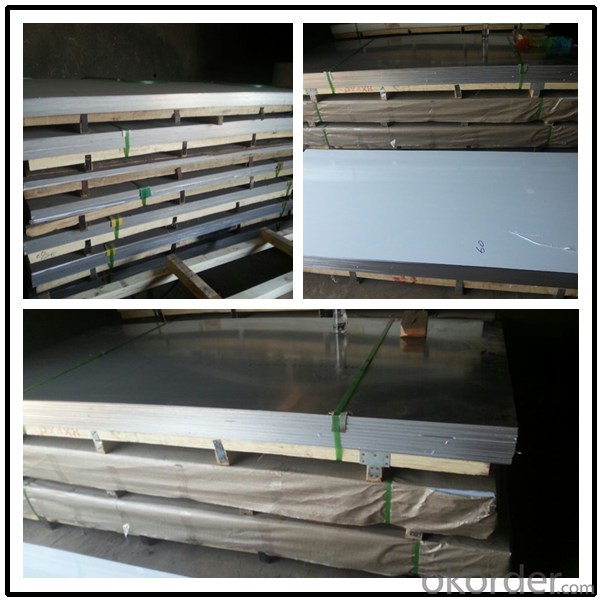
- Q:How do you protect stainless steel pipes from heat damage?
- To protect stainless steel pipes from heat damage, there are several measures you can take. 1. Insulation: Wrap the pipes with high-temperature insulation material, such as fiberglass or mineral wool, to minimize heat transfer. This insulation acts as a barrier, preventing excessive heat from reaching the pipes. 2. Heat-resistant coatings: Apply a heat-resistant coating to the pipes. These coatings are specifically designed to withstand high temperatures and provide an additional layer of protection. 3. Ventilation: Ensure proper ventilation around the pipes to dissipate heat. Good ventilation helps in maintaining lower temperatures and reduces the risk of heat damage. 4. Heat shields: Install heat shields or guards around the pipes, especially in areas where there is a high risk of heat exposure. These shields can be made of materials like stainless steel or ceramic, which can withstand high temperatures and act as a physical barrier between the pipes and the heat source. 5. Proper installation: Ensure that the pipes are installed with the appropriate clearances from heat sources. This can prevent direct contact with extremely hot surfaces and reduce the risk of heat damage. 6. Regular maintenance: Regularly inspect the pipes for signs of heat damage or deterioration. Any issues should be addressed promptly to prevent further damage. By implementing these measures, you can effectively protect stainless steel pipes from heat damage and extend their lifespan.
- Q:What is the difference between Sch 40 and Sch 80 stainless steel pipes?
- The difference between Sch 40 and Sch 80 stainless steel pipes lies in their wall thicknesses. Sch 40 refers to a pipe with a wall thickness of "Schedule 40," while Sch 80 refers to a pipe with a wall thickness of "Schedule 80." The schedule number represents the approximate wall thickness of the pipe, with higher numbers indicating thicker walls. In the case of stainless steel pipes, Sch 80 has a thicker wall compared to Sch 40. The difference in wall thickness translates to differences in pressure rating and strength. Sch 80 stainless steel pipes are designed to handle higher pressure and are generally used in applications where the pipe needs to withstand higher levels of stress or extreme conditions. On the other hand, Sch 40 stainless steel pipes are commonly used in less demanding applications where lower pressure ratings are acceptable. Additionally, the thicker wall of Sch 80 pipes results in a smaller internal diameter compared to Sch 40 pipes. This reduction in internal diameter can impact the flow rate of fluids or gases through the pipe, so it is important to consider this factor when selecting the appropriate pipe for a specific application. In summary, the main difference between Sch 40 and Sch 80 stainless steel pipes is their wall thickness, with Sch 80 pipes being thicker and capable of handling higher pressure and stress levels.
- Q:What are the different end connections available for stainless steel pipes?
- The different end connections available for stainless steel pipes include threaded connections, socket weld connections, butt weld connections, flanged connections, and compression fittings.
- Q:What is the difference between seamless and cold-drawn stainless steel pipes?
- The main difference between seamless and cold-drawn stainless steel pipes lies in the manufacturing process. Seamless pipes are made by piercing a solid billet of stainless steel and then rolling it to form a cylindrical shape, resulting in a smooth and continuous surface without any welded seams. On the other hand, cold-drawn pipes are produced by pulling a stainless steel bar through a die to create the desired shape, resulting in a smoother surface finish compared to hot-rolled pipes. Additionally, cold-drawn pipes have tighter dimensional tolerances and are typically used in applications where precision and a high-quality surface finish are required.
- Q:Can stainless steel pipes be used for oil and gas transportation?
- Indeed, the utilization of stainless steel pipes for the transportation of oil and gas is plausible. Due to its exceptional resistance to corrosion and durability, stainless steel has become a favored material choice within the oil and gas industry for pipe construction. These pipes possess the capability to endure harsh circumstances, including high pressure, extreme temperatures, and corrosive surroundings, rendering them appropriate for the conveyance of oil and gas. Furthermore, the purity of the transported fluids is maintained by stainless steel pipes, as they exhibit no reactivity or contamination towards the substances being conveyed. As a result, stainless steel pipes are an unquestionably dependable and efficient option for oil and gas transportation.
- Q:Are stainless steel pipes suitable for solar power plants?
- Yes, stainless steel pipes are suitable for solar power plants. Stainless steel is highly resistant to corrosion, withstands high temperatures, and has excellent mechanical properties, making it an ideal choice for transporting and distributing water, steam, and other fluids in solar power plants. Additionally, stainless steel has a long lifespan and requires minimal maintenance, making it a cost-effective and reliable option for the harsh and demanding conditions of solar power plants.
- Q:What is the difference between 347 and 347H stainless steel pipes?
- The carbon content is the main distinguishing factor between 347 and 347H stainless steel pipes. In the case of 347 pipes, the maximum carbon content is 0.08%, while 347H pipes have a higher carbon content range of 0.04-0.10%. This increased carbon content in 347H pipes contributes to enhanced strength at high temperatures and greater resistance to sensitization, which is the formation of chromium carbides at grain boundaries that can lead to intergranular corrosion. Because of its higher carbon content, it is generally recommended to use 347H stainless steel pipes for applications involving elevated temperatures and thermal cycling. These pipes exhibit improved resistance to creep and can withstand higher levels of stress compared to 347 stainless steel pipes. Industries such as chemical processing, petrochemical, and power generation commonly employ 347H pipes due to their exposure to high temperatures and corrosive environments. To summarize, the disparity between 347 and 347H stainless steel pipes rests in their carbon content. 347H pipes offer superior strength at high temperatures and resistance to sensitization. The choice between the two depends on the specific requirements and conditions of the application.
- Q:Can stainless steel pipes be used for food processing equipment?
- Stainless steel pipes have the capability to be utilized for food processing equipment. The food industry highly favors stainless steel due to its ability to resist corrosion, its durability, and its hygienic properties. It does not interact with food or beverages, guaranteeing the absence of contamination or alteration of the product. In addition, stainless steel pipes are easily cleaned and maintained, making them an ideal option for use in food processing equipment where cleanliness and food safety are crucial. Furthermore, stainless steel has the capacity to endure high temperatures and pressures, which are often necessary in food processing operations. In conclusion, stainless steel pipes are a suitable choice for food processing equipment and are extensively employed in the industry.
- Q:What is the average lifespan of stainless steel pipes?
- The average lifespan of stainless steel pipes can vary depending on several factors, including the quality of the stainless steel used, the environment in which the pipes are installed, and the maintenance and care they receive. However, as a general estimate, stainless steel pipes can have a lifespan of 50 to 100 years or more. This is due to the inherent corrosion resistance of stainless steel, which helps to protect the pipes from rust and other forms of degradation. Additionally, stainless steel pipes are known for their durability and strength, allowing them to withstand high temperatures, pressure, and other harsh conditions. With proper installation and maintenance, stainless steel pipes can provide long-lasting and reliable performance in various applications, such as plumbing, industrial processes, and construction projects.
- Q:Are stainless steel pipes suitable for breweries?
- Stainless steel pipes are highly suitable for breweries due to their numerous advantageous qualities. Firstly, their corrosion resistance is crucial in a brewery environment where they come into contact with liquids containing acids and other corrosive substances. This guarantees that the pipes will not rust or contaminate the beer with unwanted particles. Moreover, stainless steel pipes are highly hygienic. They are easy to clean and sanitize, which is essential in maintaining a high standard of cleanliness and preventing the growth of bacteria or other microorganisms that could spoil the beer. The smooth surface of stainless steel pipes also prevents the accumulation of residue or impurities, further enhancing the cleanliness of the brewing process. Additionally, stainless steel pipes exhibit excellent temperature resistance. They can withstand the high temperatures required for various brewing processes, such as boiling or sterilization, without deforming or losing their properties. This durability and heat resistance ensure that stainless steel pipes remain reliable and long-lasting, making them well-suited for breweries. In summary, stainless steel pipes possess a combination of corrosion resistance, hygienic properties, and temperature resistance that make them an ideal choice for breweries. They contribute to the production of high-quality and safe beer, providing a reliable and efficient infrastructure for the brewing process.
1. Manufacturer Overview |
|
|---|---|
| Location | |
| Year Established | |
| Annual Output Value | |
| Main Markets | |
| Company Certifications | |
2. Manufacturer Certificates |
|
|---|---|
| a) Certification Name | |
| Range | |
| Reference | |
| Validity Period | |
3. Manufacturer Capability |
|
|---|---|
| a)Trade Capacity | |
| Nearest Port | |
| Export Percentage | |
| No.of Employees in Trade Department | |
| Language Spoken: | |
| b)Factory Information | |
| Factory Size: | |
| No. of Production Lines | |
| Contract Manufacturing | |
| Product Price Range | |
Send your message to us
RHS Stainless Steel Pipes - Factory Price 304L Stainless Steel Sheet
- Loading Port:
- Shanghai
- Payment Terms:
- TT OR LC
- Min Order Qty:
- 5 m.t.
- Supply Capability:
- 3000 m.t./month
OKorder Service Pledge
OKorder Financial Service
Similar products
New products
Hot products
Hot Searches
Related keywords
